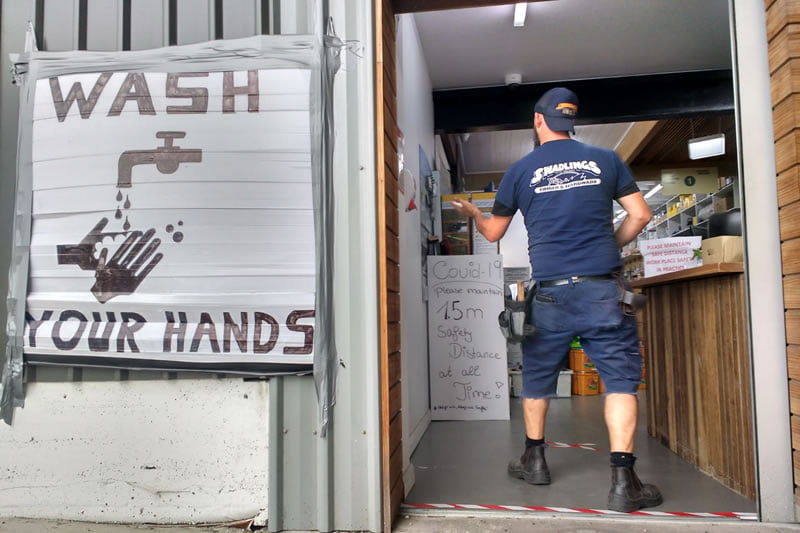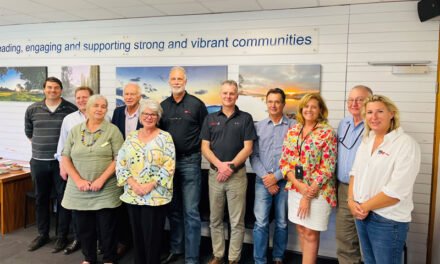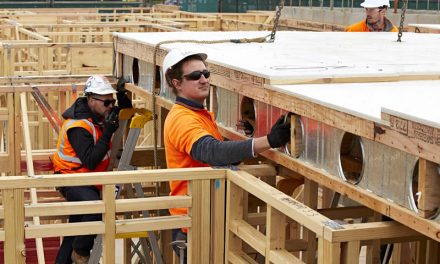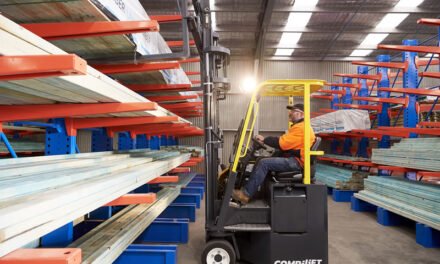We talked with three business owners about what’s changed and what hasn’t since the start of the Covid-19 pandemic – and what the future might hold.
Hand sanitiser was one of the first things to go at Swadlings Timber & Hardware. “We ran out of dust masks and sanitiser really quickly once news about Covid-19 spread,” says managing director Mark Swadling. “Then cleaning products were walking off the shelves. We were buying them in from wherever we could get them. Sanitiser wasn’t so easy, we were lucky our supplier could keep us in the foam we use for our own dispensers.”
The new pandemic normal has seen sweeping changes in the timber industry, from social distancing to a sharp drop in consumer confidence. And while there have been some upsides – DIY-focused hardware stores and garden centres have seen increased trade, and anyone with sanitiser or bog wrap is coining it – there are also plenty of pitfalls. While construction is currently listed as ‘essential’, some businesses are already seeing impacts.
Changing times
Most fabricators haven’t had a steep drop-off in business yet, but as Mallee Timber & Hardware’s Gavin Brown says of the fabrication side of their business, “We’ve seen something of a slowdown. Builders can’t have as many people on site – if you need to have the concreters there, then another trade won’t be in that day. There’s no doubling up of trades, which the building schedule would normally allow. So the work’s not being done as quickly on site and if it doesn’t get done on site, we don’t get the orders.
“Add to that there’s a bit of a general slowdown. People are worried, some more than others. There’s not much we can do: it is what it is.”
For Swadling, sales are slowing and the lack of certainty about whether construction will remain on the ‘essential’ list is causing real issues. “We haven’t had a big drop in our regular trade yet,” he says, “but there’s been a lot of cancellations for upcoming work, where people are uncertain as to whether construction is going to continue or not.”
Like Brown, builders are a key part of Swadling’s market, with the store specialising in quality and heritage timbers, restorations and machining for its substantial trade customer base.
“It comes down to the social distancing policy working,” Swadling says. “If the numbers really are curving the way they seem to be [we spoke in mid-April], that shows people are doing the right thing. Then construction sites should be able to keep going. Last week they were saying on the news that sites will be allowed to work on Saturdays and Sundays so they can keep productivity going without having too many people on jobs at the same time, but things are changing quickly.
“Residentially, people need confidence they can start their project and that it will continue – not come to a standstill for three months with their job half done. Until that confidence comes back, I don’t think there will be many new starts, whether we keep construction operating or not.”
Ironically, much of Swadlings’ regular work comes from renovating cafes, pubs, clubs and other hospitality venues across Sydney (they’re located in the Inner West). With hospitality closed down, it would be the perfect time to get work done – except there’s no money in the sector.
For now, sales are being kept up by builds that were already partway through before coronavirus. “Once they dry up, I don’t know what people are going to do,” Swadling says.
Rob Armour, managing director of frame and truss equipment manufacturing and servicing company Framequip hasn’t seen a big difference from his clients yet. “We’re still very much business as usual at the moment,” Armour says. “In terms of talking to our clients about the next few months, I’m focusing a little more on servicing, because I know some of them are worried about their bottom lines. But I’m pushing as hard as I can on sales as well, because for some companies, now’s a great time to replace or upgrade machinery while there are bigger tax breaks. I’m just keeping the full spread going and facing things one day at a time.”
As Armour says, for most businesses, it’s not their first global crisis: “Back during the GFC, I ploughed on and it meant I got through it and was really well placed to grow when things got better. I’m hoping that for a lot of us, that strategy works again, because we need a good diversity of businesses in this industry to meet the needs in boom times.
Safety first
Handwashing, social distancing and more have become the order of the day, but some protective measures are easier to put in place than others.
“It’s been pretty easy for me,” says Armour, “as a lot of what we do involves just one person. So we’re focusing on hand cleaning and have added a few extra precautions so we make sure we’re obeying the laws and keeping everyone safe.
“I’m still doing site visits. There’s no masks, but we’re all sticking to the rules about washing your hands and distancing. I’m cleaning as I come on and off sites, and it’s all working well so far.”
For a retailer, things are less simple. Swadling says he’s moved himself and a sales team member upstairs to opposite ends of the boardroom, “to give everyone downstairs more room to separate. We’ve put new signage around the business flagging sanitising stations and changed the way we’re serving: we’ve got designated areas for the customers to stand and have put screens up at the trade desk. We’re doing as much as we can.”
For Brown, it’s a multi-part process. The fabrication side of the business has been reasonably easy to adapt: “We’ve got the guys all staying at their own stations, only two people per station as much as possible and when we need more people working together on a particular job, we’re maintaining distancing.”
Things become more complicated when staff members leave the plant. “They’ve all been asked to keep to social distancing when they’re at home,” Brown says, “because if Covid does turn up at work, then the whole business will be shut down because we’ll all be off on a two-week quarantine.
“We haven’t been doing temperature checks or anything; I rely on the boys to say if they don’t feel well. They’re all pretty smart, and I have a lot of trust in them. If there’s anything they want to know or anything we’ve needed to implement then they’ve been involved in saying how they want it to happen. But we’re still doing deliveries, and that means going out to sites.”
Brown’s team has handled this by limiting the number of people in the trucks going out to sites and then implementing physical distancing once there. “When we need to unload we’ve got our person at one end and theirs at the other.
“There’s a definite change in the number of people on site. Only one trade a day instead of two or three, so it’s taking longer to get things done because you can’t have your plumbers and your electricians and your carpenters on site all at the same time because there’s too many people.”
Stimulus package
While all three said they were pleased to see the government had stepped in with stimulus packages, none are currently benefiting from the measures in place.
Brown says, “The government assistance packages have been all right if you qualify, but they’ve made the rules pretty hard to qualify. We haven’t qualified for anything with JobKeeper. They want a 30% downturn in your business, but if we had a 30% drop, we would just have to put people off. There wouldn’t be the money to pay them.”
The asset write-offs are welcome, but again, only helping certain businesses. “They might be a help, provided people have the money to spend there, but a lot of people won’t,” says Brown. “We spent some money last year, so we’ll have a fair bit to write off on our tax, but we mightn’t make the money to pay the tax.”
The team at Swadlings is just one of many businesses, including new and recently expanded enterprises, who fall foul of the narrow definitions framing the packages. “We moved sites early last year,” Swadling says. “It was a real hit and our figures were quite low for the first half of 2019 – it took us a year to get back to decent figures. So when business needs to be down 30% year-on-year going from 2019, ours isn’t. It’s down more than 30% on what we’d forecast, but we’re actually up from this time last year, because we’d only just opened up in St Peters.”
The immediate impact is that some staff will be put off. “Last year at this time we had about 28 people and now we have 40, because business had been picking up, but we’re going to have to go back to around 30. We can’t get any subsidies because the figures don’t fit what they want. But at least JobSeeker is a bit better than it was for people who end up having to use it.”
Future planning
It’s hard to make predictions when at the time of writing, there’s no good guess as to when restrictions will be easing and how lasting and significant the economic downturn will be. Armour, Brown and Swadling are all keeping a close eye on the current changes, along with some hopes for the future.
Armour remains optimistic about a reasonably swift return to something more normal: “A lot of people have slowed up a bit, but it doesn’t appear to be too bad. I think there will be a bit of a time lag for us coming out of this: for people who lose jobs, it’s going to take them a while to get a new job and then borrow money. It will be much later this year before we see a full return.”
Part of his optimism stems from the fact he is able to go on working smoothly so far. “I haven’t had any problems with supply for parts or machinery,” he says. “I have noticed that there have been price increases from some suppliers, and some of them have been blaming the coronavirus. But I think the exchange rate plays a big part in it.”
Brown hopes the restrictions in place could have some positive benefits, such as speeding the adoption of offsite construction methods. “There’s an advantage for what you can produce offsite,” he says. “We can have just three people on our machines and produce a lot of walls. And our shed’s climate controlled, so we don’t have people working out in bad weather. We can produce panels all year round and deliver them on site with a truck and it only takes two blokes to put them up.”
But it’s a guarded optimism. “Late last year, up until our December shutdown, we were going great guns. January and February are slow here, because of holidays and the heat. March is traditionally when we pick up and take off again. This March was a little down on last year, but now we’re in April, we’ve got a week’s worth of work in front of us. Normally that would be a month. On the upside, if it keeps continuing as a week out – we’ll do all right.”
Unsurprisingly for someone who works at the trade coalface, Swadling is the least optimistic in the short term. “It’s one day at a time right now. You can get an announcement and it changes everything. The reality is, this is going to be a long haul. And, in the short term, it will be devastating for the economy,” he says.
“For us personally, at this point we can pay our rent. We’re not closed, there’s still money coming in. But we’ve let our landlord know that if construction gets shut down, we’re going to be in a place where we’d like to defer our rent.”
Yet, like many of us, Swadling is thinking well beyond himself when it comes to what he would like to see come out of the crisis. “One thing that will be vital is keeping people’s credit ratings intact, so that people can still borrow money,” he says.
“The payback needs to be less strong. Rents and interest and taxes are all just compiling right now, to be paid back later. If we get the economy going and they expect everyone to have this big debt and repayments to service straight away, before the consumer spending and confidence is back, then all everyone will be doing is making money to pay debt. They won’t be putting new workers on, they won’t be buying new stuff, not spending on their business.”
He hopes that state and federal governments can work with banks and landlords to defer repayments until some time after they see the GDP going up. “It will do a lot of good to wait up to 12 months,” says Swadling. “As long as people aren’t defaulting on debts and rents, they shouldn’t be being foreclosed on or kicked out.”
He’s not alone in hoping the government maintains a greater than usual level of presence in the economy during the recovery. “Governments will need to invest until the private sector recovers,” Armour says. “Building up social housing stock is one thing that could help. One optimistic thing is that there’s a pent-up demand in Australia for private housing stock, too.”
Brown has a wider view of things. “I really do hope that as we come out of this, the government sees that we cannot rely on other people for our manufacturing industry,” he says. “In a crisis like this, we’re left struggling because we haven’t got a big manufacturing industry now. Our nail plate supplier has told us they’ve only got enough stock in Australia to get us to the end of May, for example.
“Australia had a world-class manufacturing sector even 15 years ago, and a research sector, too. We’ve lost a lot of that overseas through government policies – there’s no point saying our wages are too high when the cost of living is so high. People need to earn enough to live. We’re going to have to really reassess things for the future.”
Image: Prominent signage and foam hand sanitiser dispensers at the common entrances are helping the team at Swadlings Timber & Hardware meet the new Covid-19 OH&S rules. Additional barriers and distancing measures for staff and customers are also in place.












